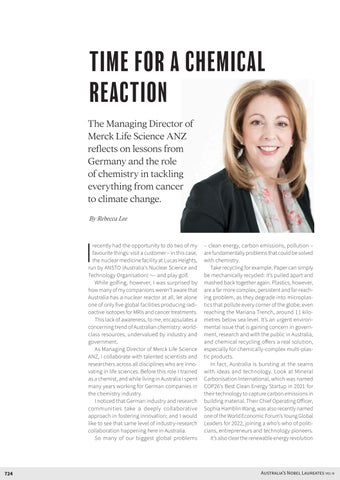TIME FOR A CHEMICAL REACTION The Managing Director of Merck Life Science ANZ reflects on lessons from Germany and the role of chemistry in tackling everything from cancer to climate change. By Rebecca Lee
I
recently had the opportunity to do two of my favourite things: visit a customer – in this case, the nuclear medicine facility at Lucas Heights, run by ANSTO (Australia's Nuclear Science and Technology Organisation) ¬-- and play golf. While golfing, however, I was surprised by how many of my companions weren’t aware that Australia has a nuclear reactor at all, let alone one of only five global facilities producing radioactive isotopes for MRIs and cancer treatments. This lack of awareness, to me, encapsulates a concerning trend of Australian chemistry: worldclass resources, undervalued by industry and government. As Managing Director of Merck Life Science ANZ, I collaborate with talented scientists and researchers across all disciplines who are innovating in life sciences. Before this role I trained as a chemist, and while living in Australia I spent many years working for German companies in the chemistry industry. I noticed that German industry and research communities take a deeply collaborative approach in fostering innovation; and I would like to see that same level of industry-research collaboration happening here in Australia. So many of our biggest global problems
724 724
– clean energy, carbon emissions, pollution – are fundamentally problems that could be solved with chemistry. Take recycling for example. Paper can simply be mechanically recycled: it’s pulled apart and mashed back together again. Plastics, however, are a far more complex, persistent and far-reaching problem, as they degrade into microplastics that pollute every corner of the globe; even reaching the Mariana Trench, around 11 kilometres below sea level. It’s an urgent environmental issue that is gaining concern in government, research and with the public in Australia, and chemical recycling offers a real solution, especially for chemically-complex multi-plastic products. In fact, Australia is bursting at the seams with ideas and technology. Look at Mineral Carbonisation International, which was named COP26’s Best Clean Energy Startup in 2021 for their technology to capture carbon emissions in building material. Their Chief Operating Officer, Sophia Hamblin Wang, was also recently named one of the World Economic Forum’s Young Global Leaders for 2022, joining a who’s-who of politicians, entrepreneurs and technology pioneers. It’s also clear the renewable energy revolution
Australia’s Australia’s Nobel Nobel Laureates Laureates VOL VOLIII III



